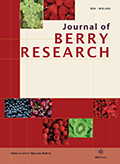Authors: Céspedes-Acuña, Carlos L. | Xiao, Jianbo | Wei, Zhao-Jun | Chen, Longsheng | Bastias, Jose M. | Avila, José G. | Alarcon-Enos, Julio | Werner-Navarrete, Enrique | Kubo, Isao
Article Type:
Research Article
Abstract:
BACKGROUND: Anthocyanins, flavonoids and organic acids widely occurring in extracts of the fruits of Aristotelia chilensis (“Maqui”), concertedly acts on the expression of cyclooxygenase-2 (COX-2), NF-κ B, HT-29 and Caco-2 colon cancer cell growth inhibition and on the production of inflammatory mediators. OBJECTIVE: To assess the anti-inflammatory effects of extracts from fruits of “Maqui Berry”, on the HT-29 and Caco-2 human colorectal cancer cell lines by measuring COX-2 and NF-κ B as well as their antioxidant activities. MATERIAL AND METHODS: Methanol/water extracts and its partitions (acetone and ethyl acetate) from three varieties of “Maqui” were
…used to access their effects on growth of HT-29 and Caco-2 colon cancer cells, COX-2, NF-κ B, NO formation, oxidations by DPPH, TBARS, FRAP and ORAC. RESULTS: Fractions rich in anthocyanins, exhibited potent chemoprotective abilities on decreasing growth of HT-29 and Caco-2 colon cancer cells. The results indicated that the extracts suppressed the production of nitric oxide (NO), through the down-regulation of inducible nitric oxide synthases (iNOS). The structural features of the extracts correlate with the inhibition of NF-κ B and COX-2 protein expressions and a potent antioxidant activity by assays of DPPH, FRAP, TBARS and ORAC. The inhibition of cell growth and NO production by selected extracts was dose-dependent with significant effects seen at concentration as low as 25.0 and 10.0 ppm, respectively. CONCLUSIONS: The phenolics (anthocyanins, flavonoids, and organic acids) that occur in extracts from Maqui berry Aristotelia chilensis may provide therapeutic potential against colon cancer.
Show more
Keywords: Polyphenols, flavonoids, anthocyanins, organic acids, antioxidant activity, Aristotelia chilensis
, Maqui berry
DOI: 10.3233/JBR-180356
Citation: Journal of Berry Research,
vol. 8, no. 4, pp. 275-296, 2018





